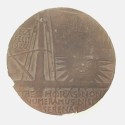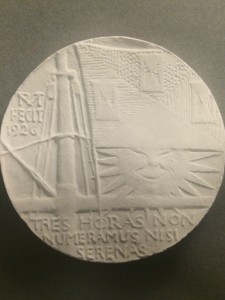A Scion Society of The Baker Street Irregulars

Christopher Morley and The Three Hours For Lunch Club Medal
“… the world’s most civilized club …”
– The Baltimore Sun

In early May, I was attending the annual meeting of the Grillparzer Club of the Hoboken Free State, a BSI scion organized by fellow Garrideb Terry Hunt that honors Christopher Morley. During the course of the three hours that we were enjoying lunch, I was approached by the editor of The Baker Street Journal, Steven Rothman, who showed me the lapel pin that he was wearing on his coat. Rothman commented that the design was based on a medal for Morley’s Three Hours for Lunch Club, and asked if I had ever seen it. When I replied that I had not, he mentioned that they had one of the medals in the archives at the University of Pennsylvania.
Later that same evening, I was lucky enough to have my train trip from New York’ to my home of Baltimore delayed by four hours. To pass the time, I started searching the internet to see if I could find any information on the medal that Rothman had mentioned. I came across the September 8, 1928 issue of The Saturday Review of Literature and on page 101 was Morley’s column, The Bowling Green. The column was titled Adventures In Hoboken and provided an update on the Three Hours For Lunch Club. In the middle of the page was a picture of a medal with the caption – “THE SUN’S OVER THE FORE-YARD, Symbolic medal designed by R. Tait McKenzie for the Three Hours for Lunch Club. The text of the column makes no reference to the pictured medal. The entire column can be read by clicking here.
Continuing to research this online, I discovered that the caption of the photo was slang used by naval officers to indicate that it was time for a drink. I also came across a poem by the same name and was pleasantly surprised to discover that Morley had written it. The poem is presented below.
The Sun’s over the Foreyard
When I was a passenger in the barque Windrush
I became aware of a pleasant sea custom.
Along toward noon
The captain’s boy used to come politely to me
And whisper
” The captain’s compliments, and the sun’s over the foreyard. “
And presently I learned that this meant
Come aft to the poop
And have a drink.
For mariners, men of sound self-control,
Never touch the bottle
Until the sun reaches the yards.
Now that I myself am a seaman
I always ship in square sail,
Never in steam.
In a steamer
The yards are so much higher.
I also came across the online inventory of the R. Tait McKenzie archive at the University of Pennsylvania and perused what was available in the 50 plus boxes of material available.
The following Saturday I was back in New York (no train issues this time!) to attend the Adventuresses of Sherlock Holmes Spring Luncheon. During the luncheon, I was seated next to Burt Wolder, one half of the team that produces the I Hear of Sherlock Everywhere podcasts. Wolder also makes the arrangements for his version of The Three Hours For Lunch Club to meet on the Thursday of BSI weekend in January the last several years. Wolder was also the person who had ordered the lapel pin that Steven Rothman had shown me the previous weekend. I mentioned that I was hoping to visit the Penn archives in the near future and Wolder mentioned that he would like to join the trip. So, on a sunny Friday in June, the two of us met up on the Penn campus.
 We had made arrangements prior to our visit to pull three boxes from the archives that seemed the best fit for our research. Our first file produced multiple photographs of the medal. These photographs, to me, appear to be identical to the picture that appeared in the Saturday Review of Literature.
We had made arrangements prior to our visit to pull three boxes from the archives that seemed the best fit for our research. Our first file produced multiple photographs of the medal. These photographs, to me, appear to be identical to the picture that appeared in the Saturday Review of Literature.
Next, we reviewed some of McKenzie’s correspondence with people whose last names started with “M.” We were hoping to possibly find some correspondence with Morley. No such luck.
The last item was a nearly four inch plaster galvano of the medal, pictured at the top of this post. Over the years, the plaster has endured a few nicks and chips to it. Holding the plaster in your hand, it really is a striking design
OBVERSE: (Tait’s monogram) / FECIT / 1926 / (a flag showing three hourglasses, on a foreyard and the sun rising behind it) / TRES HORAS NON / NUMERAMUS NISI / SERENAS
REVERSE: (blank)
99 mm, Round, Epoxy coated plaster, 12 mm thick
Now, for some speculation on my part…
I don’t believe that this medal actually exists. I believe that it only exists in this plaster format. That said, I hope to be proven wrong one day and an actual medal is found in copper, bronze, silver, gold or any other metal.
Why do I think the medal does not exist?
The picture in the September 28, 1928 issue of The Saturday Review of Literature appears to be in plaster. To me, if you were going to publish a picture of a medal, you would prefer to have the actual medal.
If the medal existed in some format, I would think pictures would exist of those rather than just the plaster version.
The Three Hours For Lunch Club had a wide and varied membership. If your were to produce a club medal, would it not be likely that they would have copies of the medal. Yet, we are not aware of any.
This was purely a social club. Would they go to the expense of having a medal struck or cast?
I would welcome your thoughts and comments.
Thanks to Timothy H. Horning of the University Archives at the University of Pennsylvania for his assistance during my visit to the Archives.

Nicely done! Good to see this being publicized —
Terry Hunt, Commissar, The Grillparzer Club of the Hoboken Free State
This story was highlighted in the July 12, 2015 issue of The E-Sylum and can be viewed at http://www.coinbooks.com/club_nbs_esylum_v18n28.html#article21.
This story was highlighted in the July 19, 2015 issue of The E-Sylum and can be viewed at http://www.coinbooks.com/club_nbs_esylum_v18n29.html#article15
This post was mentioned on page 3 of the July 2015 issue of Scuttlebutt from the Spermaceti Press, which can be viewed at http://redcircledc.org/assets/files/Spermaceti/scuttlebutt-2015.pdf
I don’t know how I happened on the original post last month. The letter in question from McKenzie to Christopher Morley is in the Morley archive at the Harry Ransom Center. It contains a pencil sketch of the medal design which is basically identical to what appears here. Naturally, I was hopeful that the medal itself would show up in the Morley personal effects, but no such luck. It was my intention to write a Ransom Center blog post about the club, but I am retiring as Assoc. Director and Librarian on Aug. 28 and unfortunately was unable to carry this out.
Rich Oram